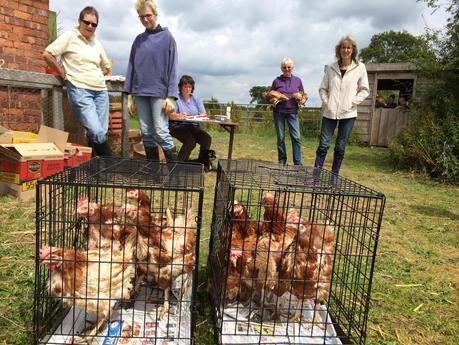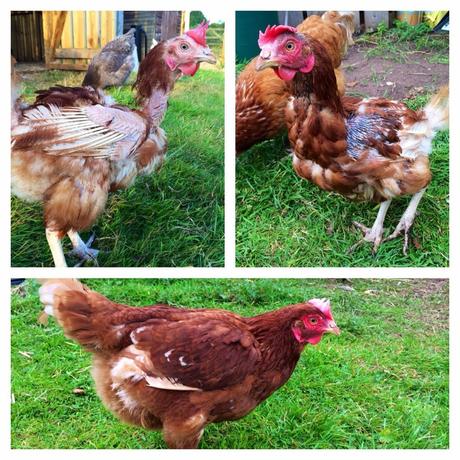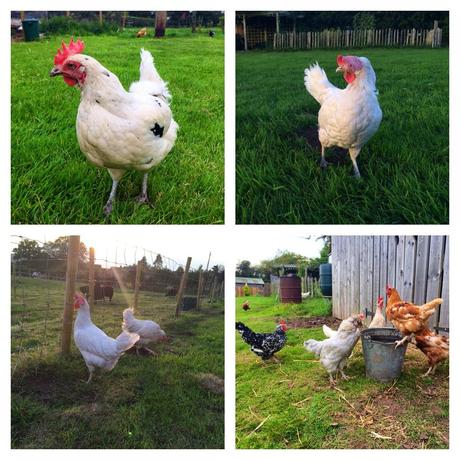
The Ex-Batts and BHWT volunteers
Back in June I drove to Oswestry for a hen rehoming organised by the British Hen Welfare Trust.
On arrival at the farm I was greeted by several volunteers, all of whom I immediately labelled as slightly mad since they all appeared to be cuddling chickens. This stereotypical view of the dedicated chicken rescuer was soon replaced with the realisation that this was in fact a very slick operation. Each of the would be rehomers, myself included, had been given allocated time slots to come and collect the several thousand hens and these ladies were simply ready and poised to help the new owners load up their hens, answer any questions and of course pose for pictures. When I said that this was going on the blog the coin flipped and they thought I was mad - touché!
Following my arrival the process seemed to move very quickly. They asked me how many I wanted, they loaded up my crates, I gave a healthy donation and away I went with 10 scraggly beasties in the back of my car. I was over the moon to have a new flock and I couldn’t have been more impressed by the volunteers and just how slick and well organised the operation was.

Yolko's progress
Once back home I could assess the new birds and they were a very sorry sight indeed. Pale, patchy with some birds almost bare and clearly stressed – I popped them in to one of the outbuildings for a couple of weeks so that they could be quarantined, wormed and left to settle in. Despite their bedraggled outward appearance the birds were in fact very healthy, heavy and alert. One hen in particular was also rather vicious. A very upright and cross beaked bird; she was determined to get me. Each time I entered the shed she would attack. Flying at me, pecking at every given opportunity and acting like a hormonal cockerel on steroids. I guess this was her way of coping with the change and she immediately earned the name Cluck Norris.
Egg production started immediately - all over the floor of the temporary shed. This made each visit to the shed quite enjoyable, a mini treasure hunt almost since they had no qualms about laying in the most unlikely of places. They soon started to come around to their new way of life though and with the introduction of a make shift egg box - a plastic compost bin with a wooden planter inside, they gradually started laying in one place making egg collection much easier. After a couple of weeks I started to let them free range and they met my existing small flock with very little fuss.
I immediately noticed that these birds are incredibly inquisitive and one bird in particular (Yolko, pictured above) is almost loving. Everyday she runs to greet me, she’ll walk around the garden with me constantly chattering away and she’ll even perch on my knee enjoying a little fuss and a cuddle. This hen was in the worst condition out of the lot on arrival with few feathers at all. After three months she has now completely feathered up and is as bright as a button.

The latest arrivals and a few of the flock
Since my initial foray in to rescue chickens, I have since rescused another six hens (this time white birds who lay dark brown and blue eggs, pictured above) and this time I got to go direct to the farm and in to the barn where they were kept. To say that this was an experience would be an understatement. 16,000 birds in a very confined space was an assault on the senses but I have to say that these birds were in fantastic condition when compared to my initial batch and kept very well in a cage free environment. This farm rehomes every 70 weeks or so (the average optimum production life of the commercial hen) and I’ll definitely be going back to save more from the meat man in future.If you are thinking of rehoming hens I'd urge you to do so as it's a thoroughly worthwhile experience. More information can be found on the British Hen Welfare Trust homepage and once registered you will be telephoned by one of their volunteers who will help you with any questions you may have.

